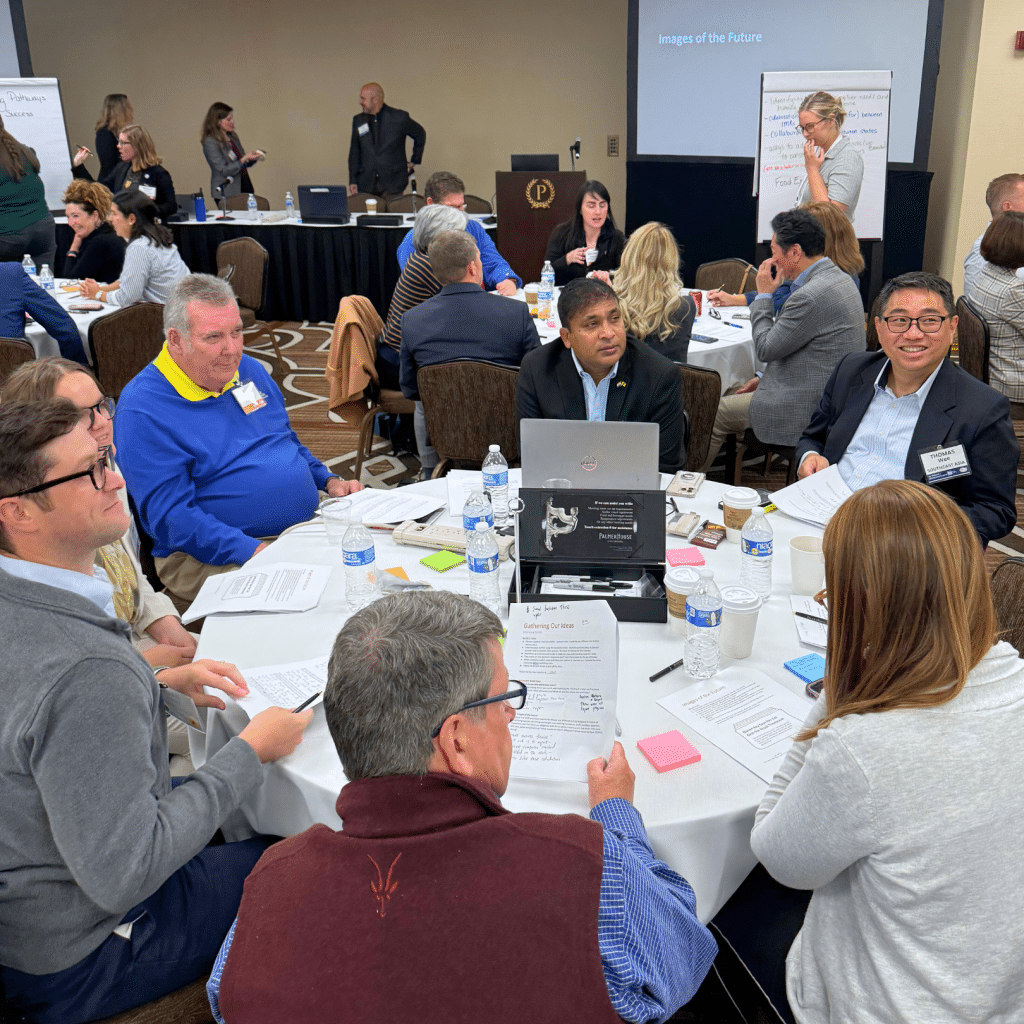Building on Strengths, Preparing for Change
Dear Food Export Community,
During a recent visit to the Art Institute of Chicago, a short walk from our office, I paused in front of American Gothic, Grant Wood’s iconic 1930 painting. What struck me wasn’t just the portrayal of resilience—of standing firm in tough times—but the quiet readiness for what lies ahead. The farmer’s steady grip on his pitchfork shows strength, but his gaze is fixed on the future. The woman beside him, with a mix of certainty and reflection, looks toward the unknown. Together, they represent not just longstanding tradition but the readiness to adapt—qualities central to our work at Food Export in these times.
In 1930, American agriculture was at a crossroads. The Great Depression devastated the economy, while new technologies like mechanization disrupted traditional farming practices. Environmental degradation in the Dust Bowl was a major concern. On top of that, the Smoot-Hawley Act, intended to protect U.S. industries, backfired by triggering retaliatory tariffs from major trade partners, causing agricultural exports to plummet. Farmers were impacted by global markets, deepening the economic crisis in rural America. Yet, despite these challenges, farmers found ways to innovate and endure.
Today, we face similar disruptions. Global trade tensions, automation (the major concern in the recent port strikes), and the growing impacts of climate change are transforming agriculture once again. But unlike in 1930, we have more tools and resources to navigate these changes. At Food Export, we continue to build on the successes of the past while preparing for a dynamic future. Resilience remains our foundation, but it’s our readiness to innovate that ensures we thrive in the years ahead.

Our partnership with the USDA’s Foreign Agricultural Service (FAS) has brought record levels of support, thanks in part to recent Regional Agricultural Promotion Program (RAPP) awards. These resources have allowed us to empower more small- and medium-sized enterprises (SMEs) to reach more markets. But as we know, funding alone isn’t enough. We must also be prepared to evolve and embrace new approaches.
We’ve implemented a strategic planning process to serve as scaffolding—a temporary structure that supports growth and change. It allows us to adapt without losing the foundation of our success. With this process in place, we can explore new markets, embrace value-added products, and position SMEs in our region for leadership on the global stage. Just as food and agriculture underwent transformation in the 1930s, today’s rise of innovative products and digitalization in marketing offers similar opportunities for growth—if we are ready to seize them.

Value-added agriculture is one of the most promising areas for expansion. Consumer-oriented goods now account for nearly half of all U.S. agricultural exports, driving economic benefits across the industry—40% of farm income now comes from value-added products. To thrive, Food Export plays a key role in helping the U.S. agricultural economy—central to much of the Midwest’s and Northeast’s economies—diversify from traditional commodities to differentiated products that stand out in competitive markets.
Emerging markets like India, Vietnam, and the Philippines represent some of the fastest-growing economies, with a rising middle class eager for high-quality, value-added food products. To meet this demand, we must be ready to lead, just as farmers did when mechanization reshaped the industry nearly a century ago.
Of course, readiness comes with challenges. Political uncertainties, changing trade policies, and supply chain disruptions will continue to test us. But with the scaffolding of our strategic plan in place, we are equipped to navigate these risks and capitalize on new opportunities. Unlike in the past, we now have the tools, knowledge, and partnerships to ensure success.
Just as American Gothic reflects both the strength of tradition and the quiet readiness for the future, we too are prepared to build on our strengths while embracing the changes ahead. By staying true to our values and remaining open to new possibilities, we can ensure a stronger, more innovative future for food and agriculture in our regions.
Thank you for your continued commitment to this journey. Together, with the support of our strategic planning process, we will rise to meet the challenges ahead and ensure lasting success for the businesses and communities we serve.
Sincerely,
Brendan Wilson
CEO/Executive Director
Your Input Matters: If there is a topic you wish for me to discuss in this space, let me know. You can reach me at info@foodexport.org. Just put Attn: Brendan Wilson in the subject line.
Your Connection To Growth®
©2025 Food Export Association of the Midwest USA and Food Export USA–Northeast. All Rights Reserved.
Food Export–Midwest and Food Export–Northeast prohibits discrimination in all its programs and activities on the basis of race, color, national origin, religion, sex, gender identity (including gender expression), sexual orientation, disability, age, marital status, familial/parental status, income derived from a public assistance program, political beliefs, reprisal or retaliation for prior civil rights activity. (Not all bases apply to all programs.) Persons with disabilities who require reasonable accommodations or alternative means of communication for program information (e.g., Braille, large print, audiotape, American Sign Language, etc.) should contact us. Additionally, program information may be made available in languages other than English.
To file a program discrimination complaint, complete the USDA Program Discrimination Complaint Form, AD-3027, found online https://www.ascr.usda.gov/filing-program-discrimination-complaint-usda-customer.
Food Export–Midwest and Food Export–Northeast reserve the right to deny services to any firm or individual which, in the sole opinion of Food Export–Midwest and Food Export–Northeast, does not comply with FAS, MAP or Food Export–Midwest and Food Export–Northeast regulations or policies, or otherwise offer the best opportunity to achieve its mission of increasing food and agricultural exports. Submission of any false or misleading information may be grounds for rejection or subsequent revocation of any application or participation. Food Export–Midwest and Food Export–Northeast are equal opportunity employers and providers.
